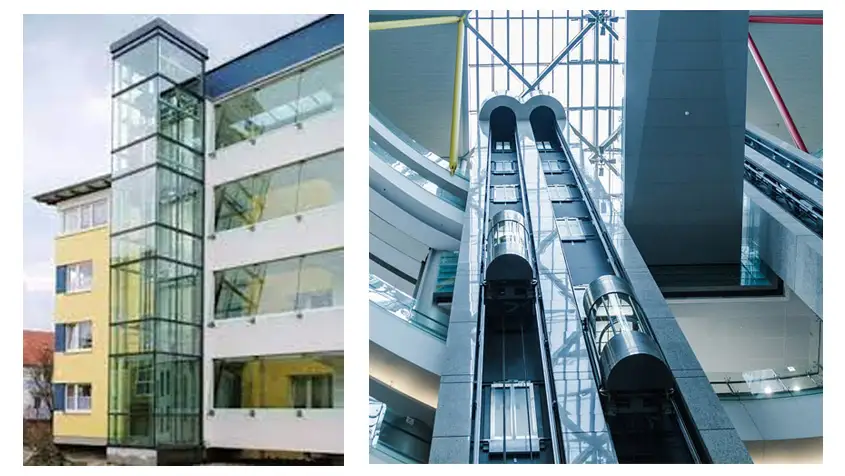What are Panoramic Elevators?
Panoramic elevators are the most popular type of elevator in the world. They are primarily used in high-rise buildings and shopping malls but can also be found in department stores and airports.

Advantages of Panoramic Elevators
They have a large number of advantages over other types of elevators, including:
- They have a small footprint that makes them ideal for small spaces like shopping malls, department stores, and airports.
- They are straightforward to install because they don’t require an extensive foundation or any additional materials like steel beams and wires to support them.
- They don’t need any special maintenance or repair work because the only thing that needs replacing is their doors every 10 years (depending on how much traffic they get).
- They can be installed on multiple stories within a building without having to worry about any structural problems because each floor has its own set of cables running through it, which means there won’t be any extra weight being added from above as long as there’s enough room for all those cables between floors! – They can be installed on a building that is already standing without having to worry about any structural problems because each floor has its own set of cables running through it, which means there won’t be any extra weight being added from above as long as there’s enough room for all those cables between floors!

Panoramic Elevator Dimensions
Size and space are key factors that determine how much a panoramic elevator can hold. The size of a panoramic elevator is determined by its cabin’s width, length, height, and depth. The space of a panoramic elevator is determined by the number of floors it can reach and its capacity to carry people and cargo.
Generally, a panoramic elevator has a cabin width of more than 2 meters (6 feet), which allows it to carry up to six people at a time. Its cabin length varies from 3 to 10 meters (10-33 feet), depending on where it will be installed. The cabin height is usually 1 meter (3 feet) above ground level, but this can vary depending on the floor plan of each building. For example, an apartment building may have a lower ceiling than other buildings, such as offices or hotels.
To calculate how many passengers can fit in a given space, you need to multiply the length by width by height: L x W x H = Passenger Capacity (PC). For example, if your building’s size is 2 x 3 x 4 meters (7 x 10 x 13 feet) with an average height of 1 meter (3 feet), then the PC would be: 2 x 3 x 4 = 24. This means that 24 people can fit in the space.
The formula for calculating passenger capacity can be applied to any building, whether it’s an apartment complex or a sports stadium. The only difference is that you’ll need to adjust the measurements of each space depending on its layout and design. For example, if your building has high ceilings and wide corridors, you may have more PC than what is listed above.

Factors to Consider When Installing a Panoramic Elevator
First, you must determine how many people will use the elevator daily. This number will help you determine how much weight it needs to support.
Second, consider how many floors your building has and what type of climate it experiences during different seasons. You’ll need a solid elevator to withstand extreme weather conditions like snowstorms or hurricanes without sustaining damage from high winds or heavy snowfall.” In addition to these factors, you’ll also want to consider what materials your building is made from. For example, if it is constructed with concrete or stone, you will need an elevator that can withstand a lot of weight and pressure without sustaining damage.
If your building is made from wood or other materials that are not as strong, you will need a lighter elevator that can carry a lot of weight but not stress the structure.

Noise Levels of Panoramic Elevators
Step 1: Noise Level Measurement
To measure the noise level of a panoramic elevator, you need to do a few things. First, you will need to find an open space with no obstructions at least 10 meters from the elevator shaft. Second, you will need to find a decibel meter. A good decibel meter should be able to measure up to 130 decibels. Next, you will need to place the decibel meter about 10 meters away from the elevator shaft. Finally, you must wait for at least 30 minutes before taking any measurements because it takes time for your ears to adjust to different noises.
Step 2: Calculating Noise Levels
Once you have gathered your data and taken all necessary measurements, it is time to calculate noise levels! To calculate noise levels with an average decibel meter, you must take two readings: one while the elevator is traveling up and one while it is traveling down. If many people in your building work on upper floors or other loud noises are coming from machines or other sources nearby, these should be accounted for when calculating final results as well; however, if there are not, then only one reading should be taken. If you are using a sound level meter instead of an average decibel meter, you will need to take three readings: one while the elevator is traveling up, one while it is traveling down, and one when it has stopped at each floor. The average decibel meter will give you a reading that tells you how loud the noise is; however, a sound level meter will tell you how many decibels there are in the environment around this particular location.
What are Decibels? Decibels (dB) are used to measure loud or quiet sounds.
They are measured on a logarithmic scale, so the difference between 10 dB and 20 dB is not twice as loud but 10 times as loud. The decibel scale can be used to compare any two sounds, even in different frequency ranges, such as frequencies from music or high-pitched tones and low-frequency rumbling sounds like traffic noise.

Safety Features of Panoramic Elevators
Step 1: The first step in the installation process is to determine the location of the elevator shaft. This will be done by an architect or engineer working with you. This step includes determining if there is sufficient headroom for installing your panoramic elevator and where it will be located in relation to other building elements like stairs and hallways.
Step 2: A pit will be dug to place the elevator car and its supporting structure. The depth of this pit will depend on where you plan to install your car and how far back from the front of your building it will be. Generally speaking. However, a pit depth of at least 12 feet is recommended.
Step 3: Once the pit has been excavated, you can begin building up its walls using concrete blocks or bricks, depending upon your preference and budget constraints. These walls should be built until they are roughly 4 feet thick at their highest point (this will vary depending on whether or not you want them to look decorative).
Step 4: Next comes laying down a series of steel beams around which will rest all other pieces that make up the supporting structure for both sides of your panoramic elevator car – these include rails along which cables attached to the car will run.
Step 5: It is time to install your rails and cables, which should be anchored at each end of the elevator shaft using metal brackets. This process is a bit more complex than laying down concrete blocks or bricks because you will need to make sure that your rails are perfectly aligned with one another on both sides of the pit before proceeding with any further steps – this may take some trial and error but once completed, you should have two parallel rails running down the length of your panoramic elevator shaft.
Step 6: Next, you will need to install a metal track on which your elevator car will travel. It is essential that this track be perfectly aligned with the rails already installed in Step 5 so that the cables connecting them are not under any strain when people ride in the elevator.

The Cost of a Panoramic Elevator
The cost of a panoramic elevator is determined by the type of elevator, the building size and layout, and how much customization is required. The average cost for a standard model is between $4,000 and $10,000 per square meter.
Panoramic elevators are created using a multistage construction process that begins with selecting materials such as steel or wood. The next step is to create an outline for the elevator in a 2D design software program such as AutoCAD. Once completed, it is transferred into 3D using specialized software such as Revit or Solidworks. This allows designers to see how everything will fit together before building anything on-site.
The next step involves determining whether any customizations need to be made so that the final product meets specific client needs. For example, suppose multiple levels within one room need access but don’t have windows or doors leading outside. In that case, we can create custom openings for those areas instead of having them open directly onto each other like most traditional designs require (such as when two stories are above ground level). This requires additional time from our architects but makes sense from an aesthetic perspective because it prevents people from seeing into other rooms and gives each level its own identity.
We can also create custom openings for things like fireplaces, kitchen islands, or walk-in closets so that they’re precisely what you want them to be. Finally, we’ll work with you on choosing the perfect exterior finishes so that they coordinate with your existing home or commercial property while still matching the overall style of our design.
We’re also happy to work with customers who want to use their basement as a family room or an extra bedroom. In this case, we can design a custom layout that takes advantage of every inch of space while creating the look and feel you want. If you still have questions, don’t hesitate to contact us.

